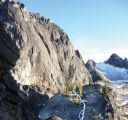Northwest Face, South Early Winters Spire III 5.11a |
||
Washington Pass, Washington, USA | ||
| ||
|
Avg time to climb route: 3-7 hours
Approach time: 1.5-3 hours Descent time: 1.5-3 hours Number of pitches: 10 Height of route: 800' Overview
The Northwest Face of South Early Winters Spire is a varied and excellent climb. The more difficult sections have good protection on solid rock with a clean fall, making it a great option for those looking to break into the 5.11a grade. Even beyond the crux pitches, the Boving Roof, the famous double roof on Pitch is 5, is incredible –steep, pumpy, mostly hand-sized jamming horizontally for more than 25 feet with lots of smearing for your feet. Despite sharing the upper part of the route with the mega- popular Southwest Rib, the Northwest Face has a secluded feel with stellar views of many of the major peaks in the area. Photos
- View all 5 photos of Northwest Face as: Thumbnails | Slideshow
Climber Beta on Northwest Face
Find other routes like
Northwest Face
Route History
The Northwest Face was first climbed in October of 1976 by Paul Boving and Steve Pollock. Boving returned in July of the following year with Matt Kerns to make the first free ascent. At the time, the two were some of Washington’s strongest rock climbers. Both were responsible for many difficult routes.Boving died in a tragic accident in 1979 while climbing Thin Fingers on the lower Index Town Wall, a route he had put up. Boving had climbed Thin Fingers twice previously but on his third ascent he fell, pulled a few pieces and hit the ledge around 30 feet off the ground, sustaining a fatal head injury. “For some reason he didn’t wear his helmet that day, even though he typically did,” recalls Matt Christensen, another talented climber from the 1970’s. About a year after Boving’s death, the cracks of Thin Fingers would become more easily protectable with a breakthrough in climbing gear – the cam. Up until the 1970s, Index was considered mostly an aid crag and Boving was one of the people at the forefront helping to change Index into more of a free climbing crag. Boving was a UW student and Yakima native who was responsible for many of the techy 5.11 crack climbs for which Index is now known. In the late 1970’s, Boving also FFA’d ROTC (5.11c) at Midnight Rock in Leavenworth and the Boving Route (5.10c) on Dragontail Peak. Strategy
While the 5.11 grade means it’s unlikely that you’ll share this route with another team except on the busiest weekends, the route meets up with the popular Southwest Rib at the top of Pitch 6.Some people think the first 5.10c/d pitch is more difficult than the second 5.11 pitch. Pitch 2 might have slightly harder moves, but the two pitches have distinctly different styles. Pitch 1 is more strenuous and committing as well as a little more devious. Pitch 2, with its short, well-protected arching finger crack, is straightforward but far more techy. This crux Pitch 2 has solid gear with a clean fall that makes it an excellent place for 5.10 climbers looking to break into the 5.11 grade. For the famed Boving Roofs, a famous double roof feature on Pitch 5, you can link Pitches 4 and 5 but this creates horrible rope drag because of the sharp change in direction and the long traverse of the double roofs. Plus it is more fun to belay below the roofs and watch your partner climb this cool feature. The double roofs are spectacular and pumpy but feature a few good rests. The crux of the pitch is transitioning from the first lower roof to the upper one. Even if not linking pitches, mind your rope drag on this pitch, extending pieces near the corner. After this pitch, the difficultly eases considerably once the route joins the upper pitches of the Southwest Rib. Many parties will leave their stuff at the base and endure the 10-15 minute hike back around after descending the South Arête. If your rock shoes aren’t too tight, this works well. Retreat Storm
There are no fixed anchors on the route; the route also traverses quite a bit, making retreat even more difficult. If you need to retreat, you would have to leave gear; two ropes would mean leaving less gear. Once at the top of Pitch 6 where the climbing eases considerably, it would be far easier and faster to climb up and descend the South Arête rather than trying to rap the route. Despite being northwest facing, the route is clean and steep and dries pretty quickly after a storm.
Everything You Need to Know About
Washington Pass
Search the internet for beta on
Northwest Face
|
Other Routes on South Early Winters Spire
|









